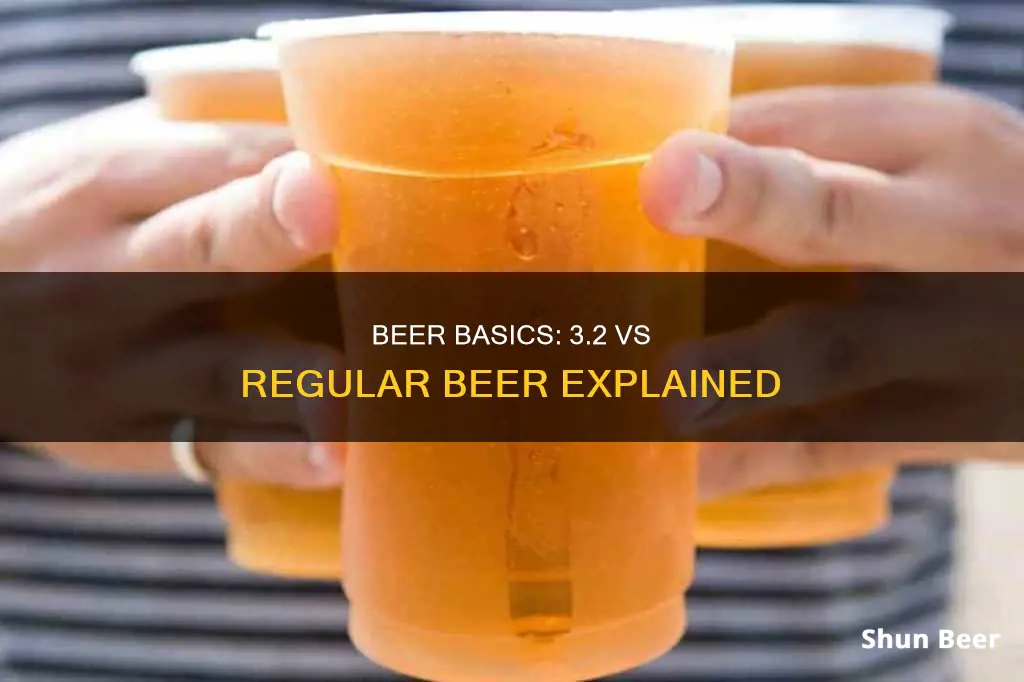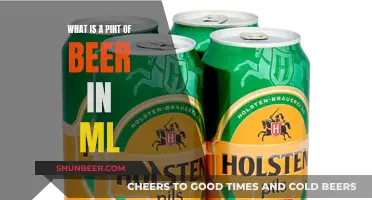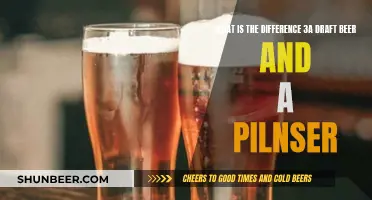
3.2 beer, also known as light beer, low-point beer, or low-alcohol beer, is a type of beer with a lower alcohol content than regular beer. It typically contains 3.2% alcohol by weight (ABW) or 4% alcohol by volume (ABV), while regular beers usually have around 5% ABV. 3.2 beer was introduced in the 1930s after Prohibition, as a compromise between allowing alcohol consumption and maintaining some restrictions. It was considered a non-intoxicating beverage and was widely available in grocery and convenience stores, especially in states that continued to restrict alcohol sales after Prohibition. While 3.2 beer has been regulated out of existence in most states, as of 2021, Minnesota was the last state still requiring grocery and convenience stores to sell this type of beer.
| Characteristics | Values |
|---|---|
| Alcohol by weight | 3.2% |
| Alcohol by volume | 4% |
| Calories | Fewer than regular beer |
| Carbonation | Less carbonated than regular beer |
| Availability | Sold everywhere, including grocery stores |
| Price | Cheaper than stronger beers |
What You'll Learn
- History of 3.2 beer: 3.2 beer was created during the Prohibition era in the US
- Alcohol content: 3.2 beer has 3.2% alcohol by weight or 4% by volume
- Regular beer alcohol content: Regular beers have around 5% alcohol by volume
- Calories: 3.2 beer has fewer calories than regular beer
- Availability: 3.2 beer is available in most states, but Minnesota restricts grocery and convenience stores to selling only this type of beer

History of 3.2 beer: 3.2 beer was created during the Prohibition era in the US
2 beer, also known as low-point beer, was created during the Prohibition era in the US. In 1917, two years before Prohibition was enacted, President Wilson proposed limiting the alcohol content of malt beverages to 2.75%. This was followed by the Volstead Act in 1919, which limited the alcohol content of all beverages to 0.5%. These very-low-alcohol beverages became known as tonics, and many breweries started making them to stay in business.
In 1933, nine months before Prohibition was repealed, President Franklin D. Roosevelt signed the Beer and Wine Revenue Act, fulfilling a campaign promise. Because Prohibition was still in effect, there had to be a limit on the amount of alcohol allowed in beer. The political process worked out a standard that could gather the necessary votes—3.2% alcohol by weight (equivalent to about 4% ABV). This became known as 3.2 beer.
After Prohibition was repealed, a number of state laws prohibiting the sale of intoxicating liquors remained in effect. As these were repealed, they were first replaced by laws limiting the maximum alcohol content allowed for sale to 3.2% alcohol by weight. In recent years, states have been scrapping these laws. As of 2019, Minnesota was the only state that permitted general establishments such as supermarket chains and convenience stores to sell only low-point beer, but it has since started allowing the sale of higher-ABV beers.
Beers Around the Globe: Exploring the Varieties
You may want to see also

Alcohol content: 3.2 beer has 3.2% alcohol by weight or 4% by volume
2 beer, also known as three-two beer, light beer, or low-point beer, contains 3.2% alcohol by weight (ABW) or 4% alcohol by volume (ABV). This equates to 3.2 grams of alcohol per 100 grams of beer or 4 milliliters of alcohol per 100 milliliters of beer.
The term 3.2 beer originated in the 1930s after the end of the Prohibition era, when states wanted to allow alcohol consumption but with caution. As a result, 3.2% ABW was considered a non-intoxicating beverage, allowing people to drink without stumbling.
Compared to regular beer, 3.2 beer has a lower alcohol content. Regular beers typically have an alcohol content of 5% ABV, while 3.2 beers range from 3.0% to 3.65% ABV. This difference in alcohol content means that 3.2 beer has a lower calorie count than regular beer, making it a healthier choice for those watching their weight.
The lower alcohol content of 3.2 beer also contributes to its affordability and wider availability. It is often sold in convenience stores, grocery stores, and gas stations, making it easily accessible.
In summary, 3.2 beer, with its 3.2% alcohol by weight or 4% by volume, is a lighter option for those seeking a less intoxicating beverage. It has a lower calorie count, is more affordable, and is widely available due to its lower alcohol content.
Explore the World of Beer: Case Options and More!
You may want to see also

Regular beer alcohol content: Regular beers have around 5% alcohol by volume
Regular beers typically contain around 5% alcohol by volume (ABV). This equates to approximately 14 grams of pure alcohol in a 12-ounce serving, which is considered a "standard" drink in the United States.
The alcohol content in beer can vary, and beers with higher or lower ABV than regular beers are available. For instance, light beers can have an ABV of around 4.2%, while stronger beers can have an ABV of 6% or higher.
The ABV of a beer is important to know, as it affects how quickly a person's blood alcohol content (BAC) rises. A higher BAC can lead to dangerous situations, such as drunk driving.
The history of beer alcohol content regulations in the United States is also interesting. The 3.2 beer, with 3.2% alcohol by weight or 4% ABV, was introduced in the 1930s after Prohibition. This type of beer was considered non-intoxicating and was even allowed in states that continued to prohibit alcohol. However, the demand for 3.2 beer has been declining, and it is now mostly found in Minnesota, with most other states allowing beers with higher ABV.
Stroh's Beer: Unique Characteristics and Distinctions
You may want to see also

Calories: 3.2 beer has fewer calories than regular beer
2 beer has a lower alcohol content than regular beer, which means it contains fewer calories. A 12-ounce 3.2 beer has about 100 calories, while a 12-ounce regular beer has 150 calories. This makes 3.2 beer a healthier choice for those watching their weight or trying to eat healthier. It's also a good choice for those who want to drink but not get drunk, as it's more challenging to get intoxicated from drinking 3.2 beer due to its lower alcohol content.
The lower calorie count in 3.2 beer is primarily due to its reduced alcohol content. Alcohol has a high number of calories per gram, so by lowering the alcohol content, the calorie count of the beer is also reduced. This makes 3.2 beer a good option for those who want to enjoy a beer without consuming too many calories.
In addition to having fewer calories, 3.2 beer is also typically less carbonated than regular beer, making it easier on the stomach. It's also usually cheaper than regular beer, so it's a more affordable option for those on a budget.
Overall, 3.2 beer is a great choice for those who want to enjoy a beer without consuming too much alcohol or too many calories. It's a healthier and more affordable option that is widely available in most states.
Beer vs Whisky: A Guide to Their Differences
You may want to see also

Availability: 3.2 beer is available in most states, but Minnesota restricts grocery and convenience stores to selling only this type of beer
2 beer, also known as three-two beer, light beer, or low-point beer, has been available in most states in the past. However, as of 2024, Minnesota is the only state that restricts grocery and convenience stores to selling only this type of beer.
The history of 3.2 beer dates back to the Prohibition era in the United States. In 1933, nine months before Prohibition was fully repealed, President Franklin D. Roosevelt signed the Beer and Wine Revenue Act, allowing beer with a maximum alcohol content of 3.2% by weight or 4% by volume. This compromise was intended to gradually reintroduce alcohol, as Prohibition was still officially in place at the time.
For many decades, states had varying regulations regarding alcohol, and 3.2 beer became a popular option in many places. In some states, it was the only type of beer allowed, while others made it more accessible than stronger beers. This was particularly true in the 1970s when many states had a minimum drinking age of 18, and 3.2 beer was the only option for teenagers.
However, over time, states started to scrap the special rules for 3.2 beer. They adopted a uniform minimum drinking age of 21 and removed restrictions on selling full-strength beer in grocery and convenience stores. This led to a decline in the demand for 3.2 beer, and brewers found it less profitable to produce.
As a result, by 2024, Minnesota is the last remaining state with laws mandating that only 3.2% beer can be sold in grocery and convenience stores. Liquor store owners in Minnesota have resisted changing this law as it has given them a mini-monopoly on the sale of beers over 4% ABV. On the other hand, convenience store owners in the state have pushed for the removal of the 3.2 beer law, arguing that it limits their customers' choices and makes it difficult to source products as brewers are phasing out 3.2 beer production.
Beer vs Spirits: Understanding Alcoholic Beverage Differences
You may want to see also
Frequently asked questions
3.2 beer is a beer with 3.2% alcohol by weight or 4% alcohol by volume. It is also known as light beer, low-point beer, or low-alcohol beer.
3.2 beer was created after Prohibition, when states wanted to be careful in allowing the manufacture, distribution, and sale of alcohol. It was seen as a non-intoxicating beverage with a low amount of alcohol that would not easily get people drunk.
The main difference is that 3.2 beer has a lower alcohol content than regular beer. 3.2 beer typically has an alcohol content of 3.2% ABV, while regular beer has an alcohol content of 5% ABV or higher.
Yes, 3.2 beer still exists and can be found in many states, although it is slowly disappearing as more states pass laws allowing the sale of higher-alcohol content beers. As of 2021, Minnesota is the last state requiring grocery and convenience stores to only sell 3.2 beer.
3.2 beer is cheaper, more widely available, and has a lower calorie count than regular beer. It is ideal for those who want to drink without getting drunk and for those trying to reduce their alcohol consumption.







